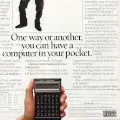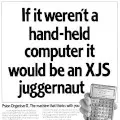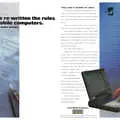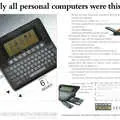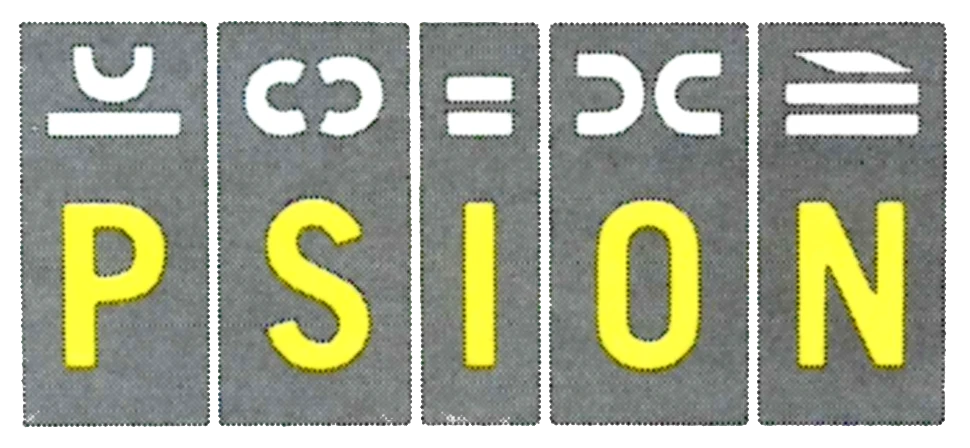
Psion Advert - August 1984
From Personal Computer World
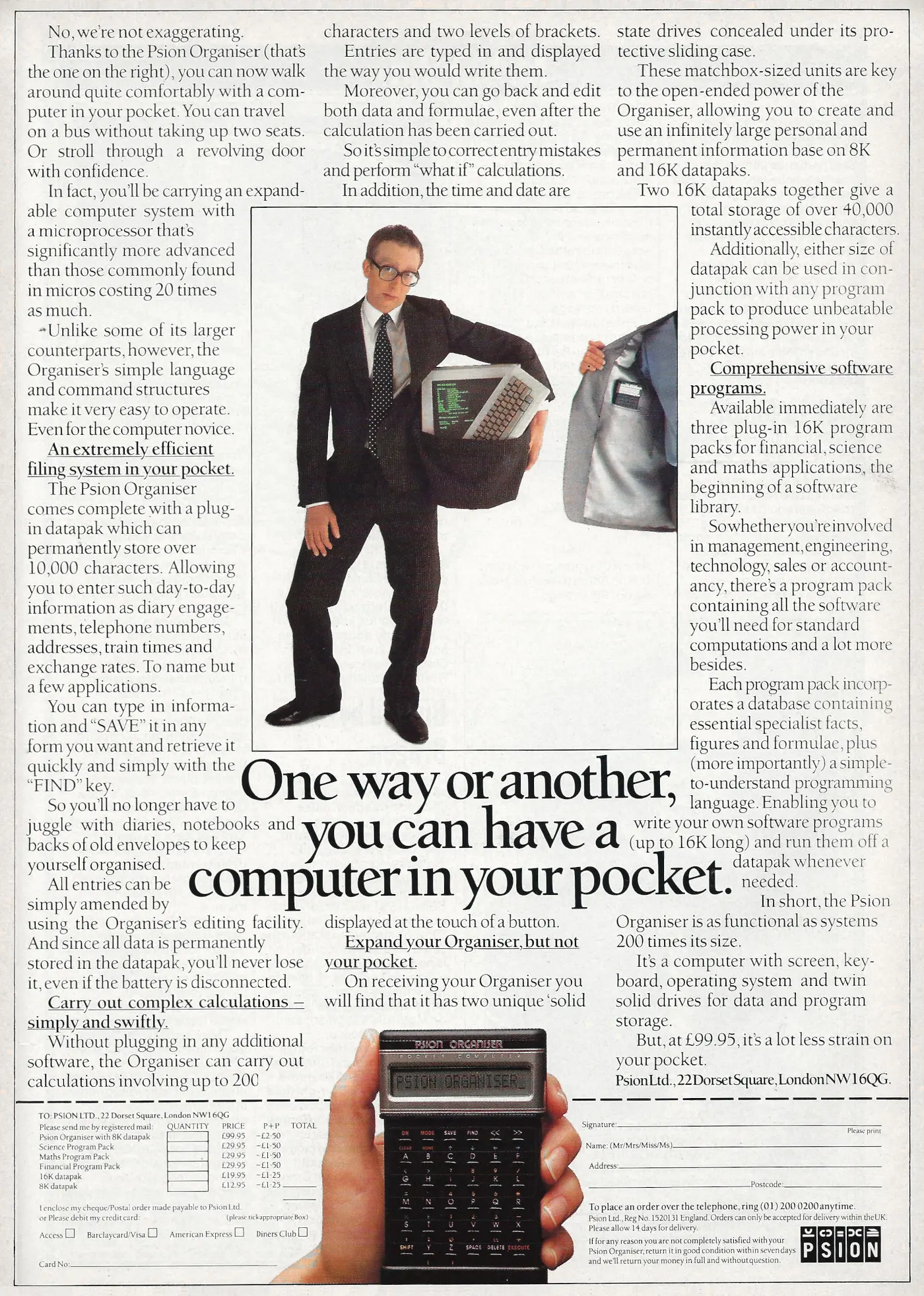
One way or another, you can have a computer in your pocket
Launched in 1984, the Psion Organiser, billed by Psion as the "world's first practical pocket computer" is considered - at least by its second incarnation, the Organiser II - as the world's first usable PDA[1].
Within a year the machine had found a niche in specialist mobile applications, for example as Medipak - a drug enquiry system containing data on 750 brand-name drugs and intended for use by non-specialist staff - or the Wessex Material Computer, as used by quantity surveyors in the construction industry.
The Organiser also spawned a range of add-ons, including barcode and credit card readers, the latter helping Psion provide 3,700 modified Organisers to Marks and Spencer for use in a credit-card validation scheme.
There was even a Forth development system, available for a snip at £500, compared to the retail price of the Organiser itself of a more reasonable £100, or around £420 in 2025.
Psion reckoned it had sold 2,000 Organisers within the first eight months since its release, with production running at 3,000 per month by February 1985.
The company also had contracts "well in excess of £1 million", which Personal Computer News took to be a sign that Psion was beginning to move away from its strong connection with Sinclair[2].
Psion had started out writing software for Sinclair's ZX80, and had produced the productivity software for Sinclair's latest machine - the QL - launched just a couple of months before this advert.
Its QL software had its roots back in 1982, at what was in hindsight Sinclair's zenith. The market at the time was becoming saturated with "innovative but incompatible hardware" with machines like the Dragon, Camputers' Lynx, the Jupiter Ace, Acorn's BBC Micro, the Oric, the Commodore 64, Atari's 400 or the Video Genie all jostling for the same market.
The founder of Psion - David Potter - questioned the long-term stability of this turmoil, saying in an interview in September 1991's Personal Computer World:
"What's the longevity of this market, what's the utility of these products, where's it going to? And the more we asked these questions the fewer answers we could get. And we came to the conclusion that these products were of tremendous educational value, a lot of fun, but there was no real long-term utility and the market was not long term because of that. So we decided to diversify and put a lot of our development resources into two very new areas for us. One was applications software. The second area was quite a new, radical concept of a handheld computer".
The idea of a handheld computer was conceived by Charles Davies - a former student of Potter's when he was at Imperial College, London, and who was now Psion's Software Director - whilst the two were at lunch in a Greek restaurant.
As the company started work on its new projects, Sinclair - which at the time was accounting for the bulk of Psion's business - got wind of its application software and approached the company about using it in its ZX83 - the machine which was to become the QL.
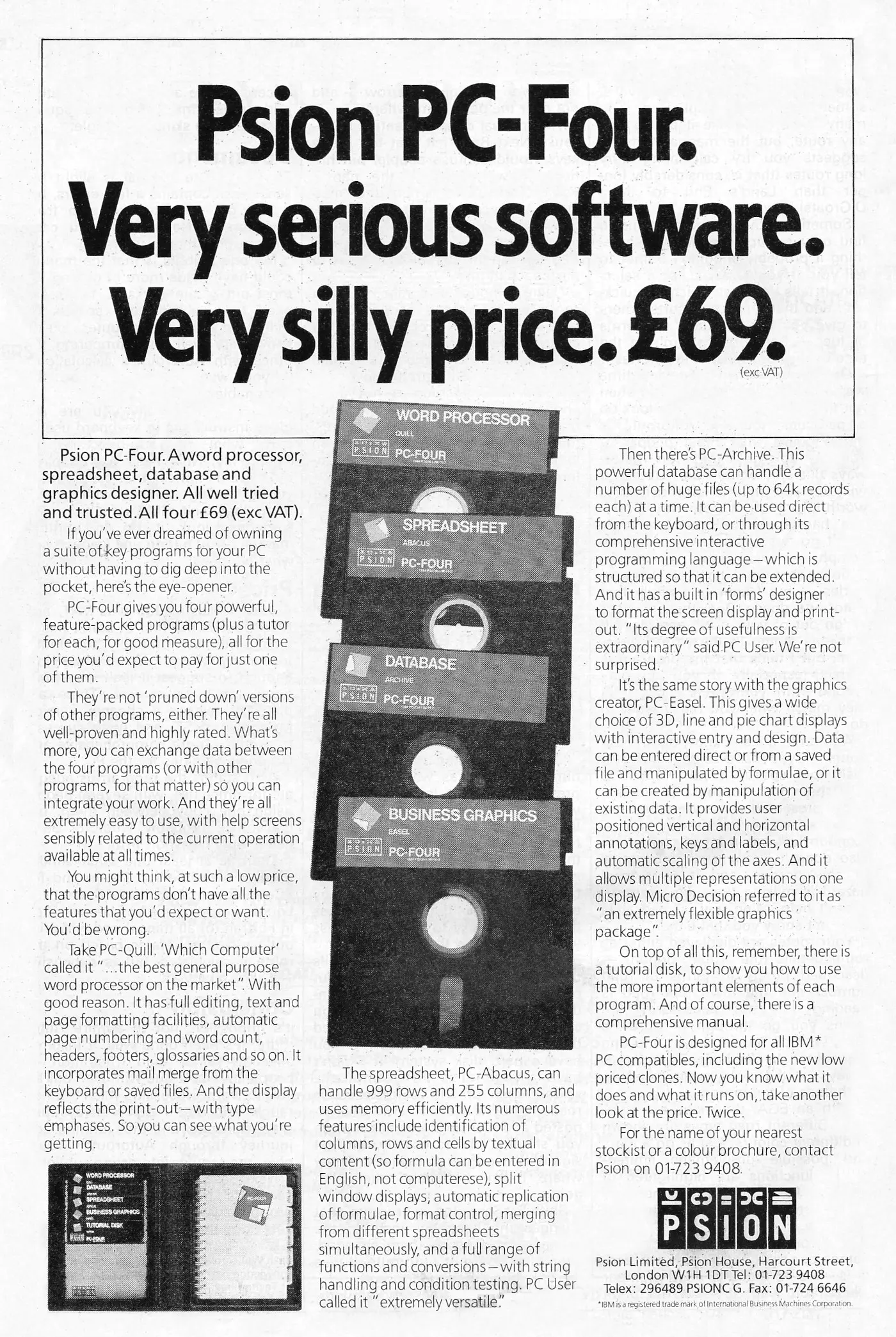
Psion's PC-4 application suite, the MS-DOS-compatible consumer version of the software that ended up on the QL and One-Per-Desk. From Personal Computer World, June 1988
Shortly afterwards, ICL - the UK's biggest computer company - also approached Psion for the same software to use on its One Per Desk - a machine which was being developed in collaboration with Sinclair and which was intended to be based on the QL.
However, significant delays in the launch of the QL left Sinclair's reputation in tatters and the machine didn't do that well. Combined with losses from spin-off Sinclair Vehicles and its C5, the company failed in 1986 and was bought for its name only by Amstrad.
Ordinarily, a company like Psion, which was heavily exposed to the fortunes of Sinclair, might have been sucked under with it - as happened with Prism, one of Sinclair's major distributors. However the company survived, not because of its application software - Lotus and later Microsoft would own that market - but because of the handheld computers it had developed.
Potter said of the initial decision to enter the handheld market that:
"It was very high risk, there's no doubt. At business schools they draw up risk tables and that down there - new product, new market, that's mega-trouble, mega-risk. On the other hand, to counter-balance that, you've got to consider some other factors. When you're a young, small company it's very difficult to enter an established marketplace where resources are much bigger. The opportunities for a young company, a creative company, are easier in some senses. They might be higher risk but they're easier, where there's new products and new markets".
The original Organiser combined a regular Intel processor with a surface-mounted circuit board developed in conjunction with defence contractor Radamec. It wasn't hugely successful, but did prime the market for when the Organiser II was launched in the following year.
Within a few years, the Organiser II had become "something of a consumer icon", with the company's turnover peaking at over £31 million by 1989 - that's about £100 million in 2025.
However Psion's luck seemed to run out in 1989 when it launched its MC notebook computer range, at the same time as the first generation of IBM-compatible notebooks were also appearing. None of Psion's MC machines had hard disks or back-lit displays, and only one even used MS-DOS. Potter said of the unfortunate timing that:
"We have not achieved the markets that we were hoping on that product. The timing was awkward and at this stage we have not established the wider markets that the product has potential for. We will evolve it, we will be adding more software and more peripherals, and we will be evolving the mix to try to get the market right[3]".
The MC range was one of Psion's SIBO - SIxteen Bit Organiser - devices[4]. Psion had developed its own multi-tasking operatings system - EPOC - for these devices, which became known as Symbian when Psion formed a joint venture with Nokia, Ericsson and Motorola. Symbian would come to dominate the mobile phone market until the advent of the iPhone and Android in 2007.
Psion continued developing various netbooks and PDAs running EPOC up until 1999's series 7, but the market was moving to cheaper models like the Palm Pilot, and PDA's based upon Microsoft's Windows CE. Psion was eventually sold to Motorola in 2012.
Date created: 15 September 2015
Last updated: 11 December 2024
Hint: use left and right cursor keys to navigate between adverts.
Sources
Text and otherwise-uncredited photos © nosher.net 2025. Dollar/GBP conversions, where used, assume $1.50 to £1. "Now" prices are calculated dynamically using average RPI per year.

